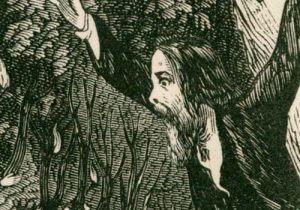Lexington, Kentucky, clergyman Robert Stuart cataloged the bodily exercises in a series of reminiscences published in the Western Presbyterian Herald (1837). For the complete text, see Stuart, “Reminiscences, Respecting the Establishment and Progress of the Presbyterian Church in Kentucky,” Journal of the Presbyterian Historical Society 23 (1945), 165–179.
2. Extraordinary bodily exercise.—On this part of the subject, I must confess that I possess no power of description, to give a vivid conception of the scene to those who have never witnessed it. I can, therefore, only record the facts. The following are the facts, as exhibited.
1. The falling exercise.—The subject of this exercise would instantly fall down, as in a swoon, and often times remain in that state of insensibility, to all appearance, for many hours. This exercise was called a trance, in which the individual professed to have seen things wonderful and unutterable; and when aroused from this state of insensibility, would, as supposed, commence a discourse that greatly surpassed the ability of the person to dictate; and therefore was esteemed by the enthusiastic as a kind of inspiration. They would also sing in what was deemed the strains of heaven.
2. Jerks.—This bodily exercise was truly wonderful beyond description. The subject of this exercise was instantly thrown, in every muscle, and nerve, and tendon, into the most convulsive state.-—His head was thrown from side to side, with such rapidity that it was impossible to distinguish his visage; and the spectator trembled for the dislocation of his neck, or lest he should dash out his brains against some obstacle. He would change his position with the rapidity of lightning, hopping over pews and benches, if in a church, so that the beholder would readily imagine that every joint in his body would be dislocated, or that he could not escape being bruised and mangled to death. He would continue thus agitated until entirely exhausted. It was useless in friends to attempt to hold him; and indeed so strangely were the minds of many warped by enthusiasm, that all attempts to hold him, to prevent injury, was striving against the Spirit of God; and he was therefore generally let alone, until the paroxysm was over, by exhaustion of physical strength. It was evident to every spectator, that this, and it may be said, in general, with respect to all the bodily exercises, that they were involuntary; for it seemed impossible that the body could be so agitated by any dictate of the will. Another fact that proved them involuntary, is, that wicked men were instantly seized with them, while guarding against them, and when seized were cursing every jerk. Also, those subject to them would take them at their daily labor, traveling by the way, and indeed in all ordinary circumstances, as well as in worship.
3. The running exercise.—The individual under this excitement would suddenly start, as in a race, and run, leaping over obstacles that chanced to be in his way with preternatural agility, until his strength was exhausted.
4. The barking exercise.—The subject of this exercise, would, with undistinguishable exactness, imitate this sagacious animal.
5. The dancing exercise.—Under this exercise the subject would dance to a lively tune, often very gracefully, but often ludicrously enough to excite, at least, a smile.
Source
Robert Stuart, “Reminiscences, Respecting the Establishment and Progress of the Presbyterian Church in Kentucky,” Journal of the Presbyterian Historical Society 23 (1945): 172–173.
